Essential Guide to Caring for Your Bearded Dragon

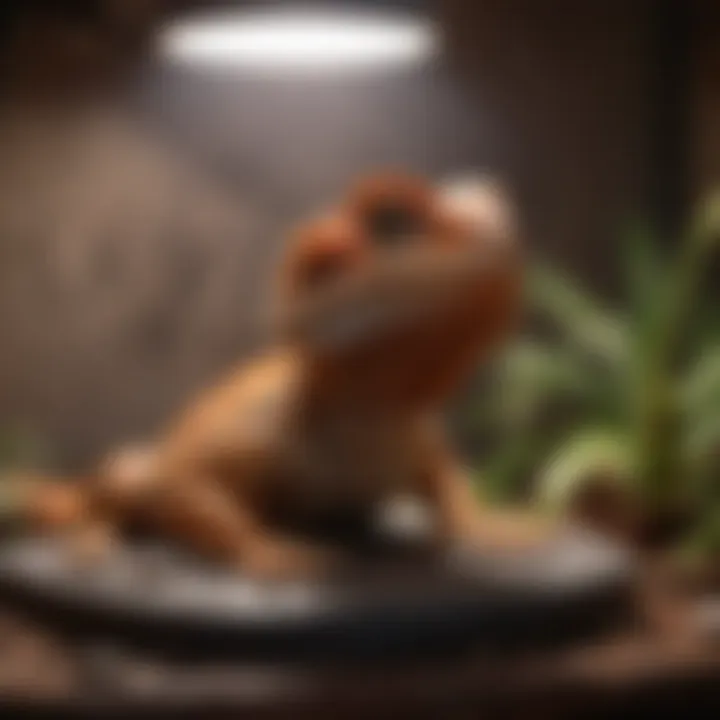
Intro
Caring for a bearded dragon requires a deeper understanding of its distinct needs. As more people welcome such reptiles into their homes, it is important to assure they are well-equipped for this engagement. Proper care encompasses multiple elements—from preparing a suitable habitat to tailoring dietary needs. This guide aims to provide an all-embracing overview. New and experienced owners can benefit from it, enriching their knowledge of responsible ownership. Understanding bearded dragon behaviors also enhances the owner-animal relationship significantly.
Care Tips
Daily Care Routines
Providing a structured routine ensures a happy and healthy environment. The first aspect is temperature regulation. Daily checks of the basking and cooler areas in their habitat assure the right temperatures—around 95 to 110 degrees Fahrenheit in basking zones and a consistent 75 to 85 degrees Fahrenheit in cooler spaces. Monitor humidity too; generally, a range of 30% to 40% is acceptable.
Feeding time should be consistent, usually once a day for mature dragons, while younger ones might benefit from two feedings. Apart from food preparation, hydration is vital. Providing fresh water in its dish daily encourages proper hydration. Interactions with the animal, such as gentle handling, contribute positively to its adjustment.
Cage Setup and Maintenance
Designing the enclosure plays a crucial role in their wellbeing. Start with a minimum of a 40-gallon terrarium for adults. Utilize heat lamps and UVB lighting to simulate their natural environment, ensuring they receive essential vitamins. Substrate should be chosen carefully—avoid loose particles as they pose risks of impaction. Prefer tile or paper towels for adult bearded dragons.
Regular inspections help maintain cleanliness. Ensure the cage is stable and free from waste at least once a week. Evaluate basking rocks and climbing branches often for dust and debris.
Hygiene and Cleaning Practices
Maintaining higher hygiene standards protects against illnesses. Start with the substrate; spot clean daily to remove any fecal matter. Weekly cleaning should involve replacing the substrate if non-digestible, wiping down surfaces with non-toxic solutions, and rinsing food dishes.
Routine disinfection practices also apply. Once a month, use a diluted vinegar-water solution on all surfaces, ensuring a comfortable living space free from harmful bacteria.
Seasonal Care Adjustments
Adaptations according to changing seasons impact health positively. During summer months, increase chances for outdoor basking under supervision. Monitor temperature fluctuations indoor and provide more cooling areas in hotter climates. During winter, provide an adequate heat source to maintain proper temperatures in tanks.
Behavioral Insights
Understanding Bearded Dragon Body Language
Minimizing stress allows bearded dragons to present their unique behaviors. Understanding body language assists in deciphering their mood. For instance, a calm bearded dragon rests with its limbs spread apart. In contrast, a standing posture indicates alertness. Specific tail positions, discovered through observation, can reflect different emotions—upturned usually indicates excitement, whereas a puffed tail may signal stress.
Common Behavioral Issues and Solutions
Often, behavioral challenges arise from improper environments or social inadequacies. If a bearded dragon displays aggressive behavior, evaluate if their habitat is too small. Ensure sufficient hiding spots and climbing opportunities. When dragons refuse food, counter by trying different angles or removing stressors from their environment.
Positive Reinforcement Techniques
Training involves creating a link between desired behaviors and rewards. Using treats like mealworms or leaf varieties after meeting basic commands fosters trust. Over time, retrospective reinforcement is critical in maintaining bonding connections and assuring behavioral consistency.
Social Interaction Needs
Social interaction is essential for bearded dragons, especially when young. Initiate health checks gently and consistently. Handling encourages interaction and reduces stress, leading to comfortable socialization in their habitats.
Nutrition Guides
Essential Diet Components
A balanced diet consists of two primary components—vegetation and protein. Adult bearded dragons benefit from around 70% plant-based materials, while about 30% consists of insects. Leafy greens and certain vegetables like carrots are nutritious and necessary additions.
Safe and Toxic Foods
Identifying safe foods remains crucial in caring. Leafy greens, squash, bell peppers, and basil are all good choices. Foods to avoid include avocado, onion, and ice plant due to potential toxicity and digestive issues.
Supplements and Treats
Calcium supplements assist in maintaining excellent health. Vitamin D3 aids absorption, especially when UVB exposure isn’t sufficient. Occasional treats like small crickets or waxworms create a joyful experience. Always compute treats carefully within feeding amounts.
Feeding Strategies for Different Species
Different morphs exhibit variable eating patterns. While most species follow general recommendations, adjusting accordingly helps ensure optimal health aligns with growth requirements or specific health needs.
Wellness and Health
Routine Health Checkups
Routine examinations by a qualified reptile veterinarian assist in prevention. Experienced owners should feel confident in specifically identifying common signs of discomfort through observations and routine check-ups.
Identifying Symptoms of Illness
Veterinarians usually stress vigilant observation. Occasionally, check for slight alterations in appetite or lethargy—these can unintentionally signal harm. Specific scents, abnormal excretions, or changes in behavior signal discomfort.
Preventative Care and Vaccinations
Consult your veterinarian regarding necessary vaccinations, aiding in the safety and well being of social populations and ensuring a vibrant environment toward continuing health practices.
Mental and Emotional Well-being
Catering to the emotional health of your bearded dragon allows for an enriched life. Gentle handling, consistent interaction, and comfortable thermal gradients create environments both stimulating and safe.
Enriching Activities
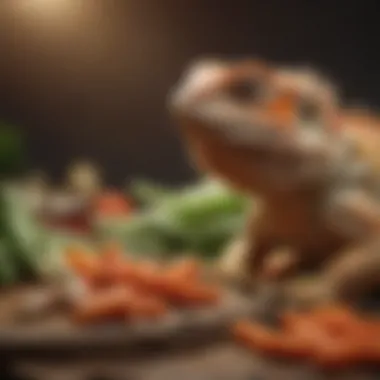
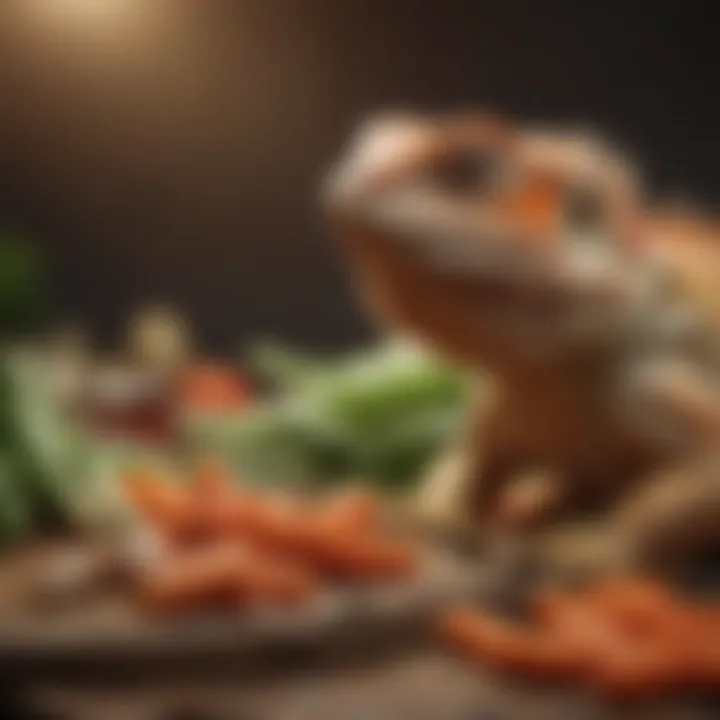
Toys and Playtime Ideas
Toys designed for reptiles can prompt new creativity and keep agitation at bay. Moreover, the thoughtful provision of climbing frames and healthy hideaways within the habitat increases interest in their surroundings.
Training and Tricks
Physical activity is integral to development; gradual challenges stimulate learning. Start basic commands then implement them into daily routines which serve to bridge company needs and develop cohesively into an expected dynamic.
Outdoor Activities and Interaction
Consider supervised outdoor sessions for natural heat absorption or mental explorations. Here, measure outdoor temperatures thoroughly, aligning them with your pet’s range.
DIY Projects for Mental Stimulation
Create occasions for engagement and enhances mental aerobics due to the potential rewards of simple DIY projects— wall climbing frames, sensory boxes filled with flags or hides invoke superior engagement by stimulating internal discovery into activity-based systems.
Thus being equipped with knowledge fosters expected augmentation to behavioral adaptability and with physical and emotional activities designed intentionally.
Living well comes through respecting an animal’s requirements throughout persistent engagements; one may bring tranquility to these noble creatures.
Prolusion to Bearded Dragons
Bearded dragons are becoming increasignly popular as pets. This section helps owners understand vital aspects of these reptiles, enabling better care and owner satisfaction. Understanding the species and its requirements is crucial for those considering adding a bearded dragon to their family. This care guide will provide detailed information on their habitat, dietary needs, and everyday care practices. Tulking about your responsibilities helps ensure that these charming reptiles thrive in captivity.
Understanding the Species
Bearded dragons belong to the family Agamidae and are native to Australia. Recognized for their distinct flattened bodies and regal appearance, they thrive in arid and semi-arid environments. There are different species, with the central bearded dragon being the most common in captivity. These reptiles exhibit unique behaviors and personalities that can engage owners and pet enthusiasts alike.
A few critical characteristics to note include:
- Diet: Bearded dragons are omnivorous. They eat both plants and insects, making varied nutrition essential.
- Temperament: Many bearded dragons exhibit calm and sociable behavior, making them excellent companions.
- Adaptable: They can adjust to different temperatures, but proper heating and lighting are necessary for ensuring their health.
Understanding these elements promotes responsible care and enhances the owner-roptile relationship.
Lifespan and Growth Patterns
The lifespan of a bearded dragon typically ranges from 8 to 15 years. This is heavily influenced by their environment, diet, and overall care. In the first few months, these reptiles grow rapidly, being one of the fascinating aspects observed by enthusiasts and owners.
- Growth Stages: They experience noticeable growth in stages, starting from hatchlings to juvenile. During their time as juveniles, proper nutrition influences health.
- Maturity: They reach sexual maturity around 6 to 12 months, which shapes behavior changes.
- Senior Age: As they age, owners should be prepared to adapt their diets and habitats since this can significantly impact health.
Keeping note of these growth patterns is practical for owners. Dedication to addressing their needs at each stage contributes to a long and fulfilling life for these distinctive creatures. Caring for a bearded dragon necessitates knowledge and responsibility, ensuring that every stage of their development is addressed appropriately.
Setting Up a Suitable Habitat
Creating an appropriate habitat for a bearded dragon is critical for its overall well-being. The right environment mimics its natural surroundings and influences behavior, health, and life expectancy. Establishing a suitable habitat demonstrates a commitment to responsible ownership, ensuring that these distinct reptiles can thrive.
Choosing the Right Enclosure
Selecting the right enclosure involves several considerations. Size is a prominent factor: a bearded dragon needs adequate space to move, bask, and hide. Consider a minimum of 40 gallons for an adult, with height and length about 48 inches to allow for climbing. Materials like glass or fiberglass can provide good visibility while protecting heat levels. Adequate ventilation is essential to prevent moisture buildup and exposure to bacterial growth.
Of course, avoid overcrowding. Excessive decorations can hinder movement and create stress. Prioritize a straightforward layout that incorporates hiding spots, branches, and basking areas.
Temperature Requirements
Temperature regulation is vital for the health of bearded dragons. They are ectothermic, meaning they rely on external heat sources to maintain their body temperature. A thermal gradient within the enclosure helps provide areas for both basking and cooling down. The basking area should maintain temperatures around 100 to 110 degrees Fahrenheit, while the cooler side can range from 75 to 85 degrees Fahrenheit. Keeping a reliable thermometer to monitor these conditions reduces stress for your pet.
Key Points About Temperature:
- Place heat sources safely: Use basking lamps above the enclosure for adequate coverage.
- Avoid extreme fluctuations: Consistency in temperature prevents health problems.
- Utilize nighttime cooling: Allow temperatures to dip to more natural levels during the night.
Lighting and UVB Needs
Proper lighting, particularly UVB light, is crucial for a bearded dragon's health. UVB radiation facilitates Vitamin D3 synthesis, aiding calcium absorption and preventing metabolic bone disease. A UVB bulb should cover the basking area. Replace these lamps every six months to maintain proper output levels.
Balancing daylight is equally important. A cycle of 10 to 12 hours of light each day mimics natural conditions. Ensure that shadows, bright spots, and semi-dark hiding spots provide visual depth in the habitat.
Lighting Considerations:
- Light type matters: Use basking bulbs paired with UVB fixtures.
- Monitor basking time: Ensure your dragon doesn't stay excessively close to light sources, as overheating can occur.
- Regular checks: Confirm UVB output and replace bulbs routinely for optimal functionality.
Substrates and Furnishings
The substrate, or bottom material of the enclosure, needs to support your bearded dragon throughout its life. Newspaper, paper towels, or reptile carpets serve as appropriate substrates. They are easy to clean and minimize possible ingestion hazards. Avoid loose substrates like sand or wood chips, as they can lead to impaction.
When it comes to furnishings, create an environment that mimics their natural habitat. This includes rocks for climbing, logs to bask upon, and family-friendly kazags or hideouts. Each layout should allow for activity and exploration while facilitating nap or retreat options as needed.
Successful habitats include:
- Basking rocks or platforms: To meet heat and light needs.
- Hiding spaces: Allow for natural instincts.
- Climbing objects: Promote exercise necessary for health.
To conclude, the setting up of an appropriate habitat affects a bearded dragon's overall well-being. Consideration of elements like enclosure size, temperature, lighting, and engaging furnishings ultimately contributes to the longevity and quality of life for these fascinating reptiles.
Nutrition and Feeding Guidelines
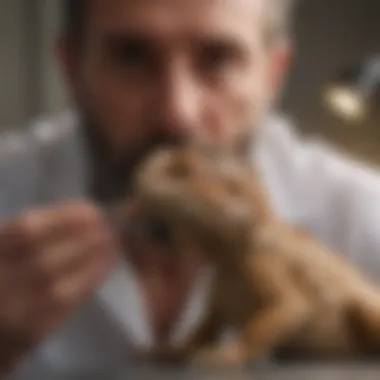
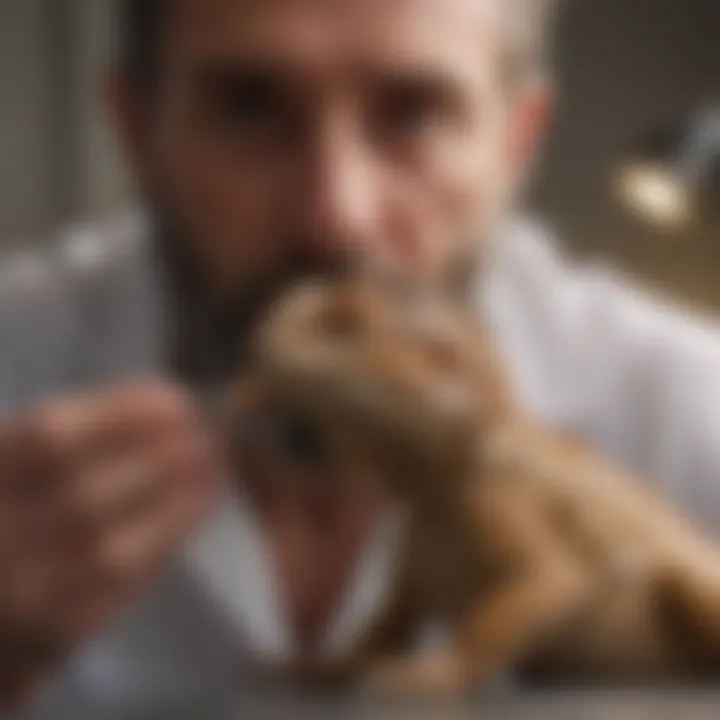
Nutrition plays a critical role in the overall health and well-being of bearded dragons. A proper diet directly influences their growth, vitality, and longevity. Owners must ensure that their pets receive a balanced nutritional profile that mimics their natural dietary needs in the wild. Bearded dragons are omnivores, demanding a mix of protein, carbohydrates, and vitamins. As their caregivers, it becomes essential to understand these requirements thoroughly.
Understanding Dietary Requirements
To provide a sound diet, it's important to recognize what bearded dragons actually consume in the wild. In their natural habitats, they predominantly eat insects, leafy greens, and various plants. Therefore, their diet should similarly include:
- Proteins: Crickets, mealworms, and superworms serve as high-protein options. These insects contribute to proper muscle and tissue development.
- Vegetables: Leafy greens like collard greens, kale, and dandelion greens should form the primary staple of their diets. These provide essential nutrients for calcium and hydration.
- Fruits: Fruits should be offered sparingly. Options such as mango, blueberries, and papaya can serve as treats.
Owners should also pay attention to the ratios in servings. A general rule is to focus on offering 70-80% vegetables and plant materials and 20-30% insects at adult stage.
Selecting Appropriate Foods
Choosing the right foods requires consideration of specific nutritional benefits and any dietary restrictions observed in bearded dragons. Here are some trusted options:
- Insects: Various insects like crickets or hornworms are great for protein. It's smart to avoid fireflies or very large insects that might pose choking hazards.
- Greens: Avoid any high-oxalate vegetables such as spinach or beet greens in large quantities as they can interfere with calcium absorption. Instead, look for nutritional substitutes like mustard greens or endive.
- Commercial Diets: There are also specially formulated commercial diets available specifically for bearded dragons. These should not entirely replace fresh diets but can be useful as complementary feed.
Remember to scratch below the surface on what links the food provides in terms of vitamins, fiber, and hydration. This diligence fuels better care and a healthier pet.
Supplementing Diet with Vitamins
Omnivorous reptiles have different requirements when compared to solely insectivorous counterparts. Hence, randomly feeding a diet consisting of insects alone is insufficient. Proper supplementation is necessary to stave off nutritional deficiencies. Especially crucial are:
- Calcium Supplements: A calcium supplement should be dusted on insects and greens three to four times a week. Bearded dragons require generous amounts of this mineral.
- Vitamin D3: It enables calcium utilization in the body. If UVB lighting is insufficient, offering a vitamin D3 supplement every few weeks unceasingly will help achieve accessible calcium metabolism.
Establish a schedule for when these vitamins and supplements should be introduced into their diets. Systematic inclusion helps eliminate guesswork. Avoid overdose; following recommended dosages on supplement packaging assures compliance.
A well-balanced diet, alongside regular veterinary oversight, sends owners and their bearded dragon on a path of robust living.
In summary, owners play a vital role in ensuring proper nutrition for their bearded dragons. When laying foundations for a healthy relationship, thoughtful consideration of diet is where you start.
Health Care Essentials
Providing appropriate health care is fundamental when it comes to owning a bearded dragon. Not only does it ensure the well-being of the pet, but it also helps the owner feel reassured. Regular check-ups and appropriate management of health issues lead to a longer, more fulfilling life for the reptile. Understanding the significance of these essentials creates a stronger bond between the bearded dragon and its owner.
Regular Veterinary Check-Ups
Routine veterinary check-ups are essential to maintaining a bearded dragon's health. A qualified veterinarian can monitor the pet's overall wellness, which includes physical examinations and wellness panels. These exams help to catch any health issues early. Additionally, the function of these check-ups extends beyond mere inspection; it provides opportunities for owners to ask questions about concerns, diet, and the habitat.
It's recommended to schedule check-ups at least once per year for adult dragons, while younger or sick dragons may need more frequent visits. In such consultations, the vet may check the following:
- Body weight
- Skin condition
- Eyes and mouth for any abnormalities
- Fecal tests for parasites
- Overall behavior and activity level
The earlier that unusual signs can be addressed, the healthier and happier the creature will be.
Identifying Common Health Issues
Awareness of the typical health problems that bearded dragons face is critical for every owner. Common conditions include metabolic bone disease, respiratory infections, and parasites. Knowledge about these issues can help in identifying symptoms so that prompt action can be taken.
- Metabolic Bone Disease (MBD): This can result from inadequate calcium intake or inadequate exposure to UVB light. Symptoms include swelling, lethargy, and deformities in the limbs.
- Respiratory Infections: These are often linked to inadequate temperatures or humidity levels in the habitat. Signs may include wheezing, nasal discharge, or flaring nostrils.
- Parasites: Bearded dragons can contract both external and internal parasites. Signs may include a change in appetite, weight loss, or swollen belly.
Since many health issues can appear subtle at first, regular monitoring is essential. Keeping track of behavior changes and knowing what to look for will prepare the owner should a problem arise.
Preventative Care Practices
Establishing a proactive approach can dramatically improve the well-being of your bearded dragon. Investing time in preventative care not only reduces the likelihood of diseases but also fosters a longer lifespan through better radiant health.
To facilitate good health, consider these practices:
- Maintain a Balanced Diet: Feed a mix of vegetables and protein sources in suitable quantities for age and size.
- Optimize Their Habitat: Clean the enclosure regularly, adjusting temperature and moisture levels.
- Provide UVB Lighting: Proper lighting replicates natural sunlight, aiding in vitamin D synthesis.
- Hydration: Ensure clean, fresh water is always available, adjusting for environments that might dry out.
Regular checks and attentiveness to changes in your bearded dragon's health can prevent minor issues from escalating.
Navigating health care essentials requires diligence but it is also rewarding. The bond formed benefits both the pet and the owner tremendously. By committing to comprehensive preventive measures and staying alert to possible concerns, a rich and interactive relationship with a bearded dragon is achievable.
Behavioral Insights and Socialization
Understanding the behavioral patterns and socialization needs of bearded dragons is crucial for their care. These insights play a significant role in their well-being and compatibility with their owners. By knowing their natural instincts, pet owners can adjust their practices to foster a healthier and more enriching environment. The relationship between the dragon and its owner can enhance the experience not only for the reptile but also for the household.
Understanding Natural Behaviors
Bearded dragons exhibit various instinctual behaviors driven by their evolutionary background. Observing these actions provides insights into their needs and preferences. They are diurnal creatures, primarily active during the day. This must influence the layout of their habitat and their feeding schedule.
Laying flat on rocks or basking under heat lamps are common behaviors. This action is essential for thermoregulation. Bearded dragons also engage in head bobbing, which is a part of their communication, often expressing dominance or submission through this behavior. Being aware of such behaviors enables owners to respond appropriately, ensuring positive interactions. The natural behavior of basking and social interactions can inform the configuration of their environment. It helps foster a natural feeling ambience in the enclosure.
Social Interaction with Owners
Socializing with a bearded dragon can significantly influence its temperament. Bearded dragons may not have the same social structure as mammals but they can develop bonds with their caretakers. It is important to regularly handle them. Start with short sessions to get them used to human interaction, gradually increasing the time as they become more comfortable.
Establishing trust is central to successful interaction. Bearded dragons may display calming behaviors when they feel secure. This reinforces the bond between them and their owner. Furthermore, bearded dragons can recognize their owners by sight and may even come to them when called. This personalization aids in strengthening their relationship, making them feel safer and more at ease in their habitat.
To enhance this relationship:
- Always approach slowly to avoid startling them.
- Offer food from your hand which promotes a positive association.
- Allow them to explore your hand without forcing contact.
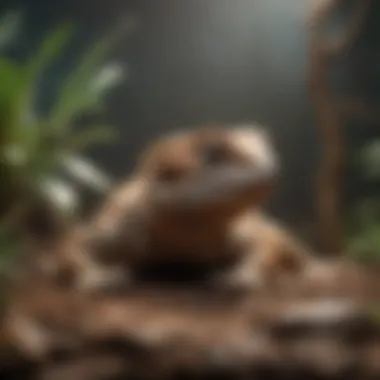
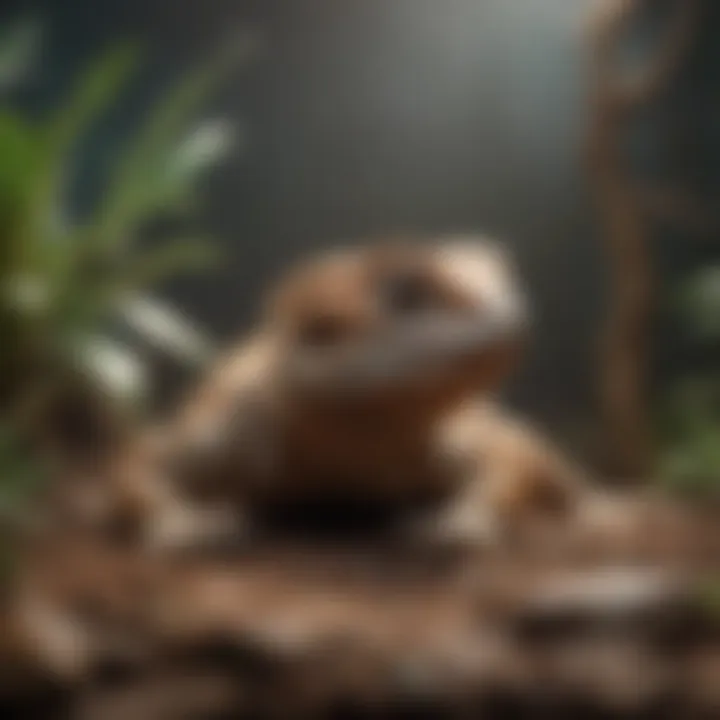
Reducing Stress and Anxiety
Maintaining a low-stress environment is critical for the health of a bearded dragon. Stress can bring about a range of health issues including loss of appetite, scales discoloration, or even graphic behavior changes. Creating a familiar routine can help minimize anxiety for these creatures. Familiarity offers comfort and a sense of security.
Identifying potential stressors is equally important. Given their shy nature, loud noises, sudden movements, or even aggressive pets can cause anxiety. Therefore, protecting them from these experiences is beneficial. Provide hideouts in the enclosure to give them a safe place to retreat when feeling threatened is also beneficial. Regular interactions should focus on positive reinforcement, allowing them to express their natural behaviors while feeling secure.
In summary, understanding and adapting to a bearded dragon's behavioral patterns fosters a positive and healthy relationship. Skills in observing natural instincts and social engagement techniques enrich their lives, providing a more fulfilling experience for pet owners.
Maintenance and Care Routine
Maintaining a bearded dragon goes beyond providing an appropriate habitat and diet. A structured care routine is vital to their health and well-being. Well-planned maintenance not only aids in recognizing health problems early but also contributes to long-term happiness. Consistency in care provides stability, allowing your reptile to live a productive life.
Daily and Weekly Care Tasks
Establishing daily and weekly routines are critical for optimal care.
- Daily Tasks:
- Weekly Tasks:
- Feeding and Hydration: Ensure that you provide fresh food daily, replenishing water to keep your dragon hydrated.
- Check Thermometer and Hygrometers: Monitor temperature and humidity levels to ensure that they align with your dragon's needs.
- Observation: Spend a few minutes every day observing your bearded dragon. Looking for unusual behavior, limpness, or lethargy can be a sign of health issues.
- Feed Variety: Change the diet offerings to ensure balanced nutrition.
- Bathe Your Dragon: Providing a short soak can help with hydration and shed skin removal.
- Inspect Decorations and Accessories: Check for damages to avoid harm during interactions or playtime.
By establishing these routines, you can develop a reliable plan to support the health of your bearded dragon.
Cleaning the Enclosure
Maintaining cleanliness in your bearded dragon's enclosure is essential. A clean living space reduces the risk of infections that can affect your pet's health. It also makes for a more aesthetically pleasing environment.
- Daily Spot Cleaning: Remove any uneaten food, feces, or old substrate daily. This can prevent bacteria from accumulating.
- Weekly Deep Cleaning: Every week, completely clean the entire enclosure. Remove all furnishings and scrub the surfaces. Use a safe reptile-approved cleaner and rinse thoroughly.
- Replace Substrate Monthly: If you use a substrate, those should be replaced on a monthly basis. A dirty substrate can lead to health issues.
It is important to manage hygiene actively. A clean environment leads to a healthier bearded dragon.
Monitoring Behavior and Health
Observing your bearded dragon regularly encourages prompt recognition of any behavioral or health changes. Reptiles are not as vocal as pets like dogs or cats, making careful observation key.
- Look for Changes in Appetite: An unexpected change in eating habits may indicate problems.
- Monitor Activity Levels: Bearded dragons are known for being active—changes here can signify health issues.
- Behavioral Signs: Look for signs such as glass surfing, which may indicate stress or discomfort.
Daily interaction, routine checking, and sudden awareness can lead to early intervention if needed. Regular communication with a vet ensures long-term health.
Regularity in checks and balances leads to sustained bearded dragon health, enhancing both their life and your connection with them.
Common Misconceptions about Bearded Dragons
Understanding common misconceptions about bearded dragons is essential for creating an optimal environment and ensuring that keepers provide the correct care. These reptiles are often described as low-maintenance pets, yet this perspective may give a false sense of security regarding their needs. Caretakers who overlook specific requirements may inadvertently put their pets' health at risk. Knowing the common myths influences how bearded dragons are treated in captivity and can promote a more informed approach to pet ownership. Understanding these misconceptions is not just about providing correct information; it is about fostering a better bond between the owner and the animal.
Myths Regarding Diet
One prevalent myth is that bearded dragons can thrive on a strictly insect-based diet. While insects provide essential protein, they cannot be the sole source of nutrition. A varied diet must include vegetables and fruits. Younger bearded dragons may benefit more from insects while adults require a higher proportion of plant matter.
- Insects: Crickets, mealworms, and dubia roaches support growth but should not be the only foods.
- Vegetables: Leafy greens like collard greens and kale provide important vitamins.
- Fruits: Offer treats such as strawberries or mango on occasion.
Another misconception is that all insects can be safe to feed. In reality, allowing it imposes risks like parasites. Therefore, catching insects from the wild is risky and unsafe. Insects purchased from reputable suppliers are a more suitable choice. Proper vitamin and mineral supplementation helps assure a balanced diet. Ignoring diet diversity can lead to malnutrition, impacting overall growth and quality of life.
Misunderstandings on Habitat Needs
The environment in which a bearded dragon lives has complexities often underestimated. Some may believe that bearded dragons can adjust to any home condition as long as they have some light. However, achieving correct temperature and humidity levels is paramount.
Key environmental factors include:
- Basking Spot Temperature: Temperatures should reach between 100°F and 110°F. A thermometer can assist in monitoring.
- Cool Side Temperature: This should generally stay around 70°F to 80°F to mimic natural behaviors and choices.
- Humidity Levels: Ideal humidity sits between 30-40%. Too much or too little can cause health concerns.
Enclosure size is also integral. A cramped enclosure prevents freedom crucial for activity and behavioral expression. A 40-gallon tank is the starting at a minimum for an adult. The placement of basking bulbs and UVB lights substratum is also essential and should be considered seriously. Overlooking these habitat needs will lead to either stress or health issues. Ensure that enclosures are spacious and correctly stocked with items like climbing and hiding spots.
Misunderstandings can easily develop, but detailed knowledge about diet and habitat care binds the owner to the responsive handling of their wonderful reptiles.
Ending: Responsible Ownership
Responsible ownership of bearded dragons is a crucial aspect that highlights the significance of a dedicated pet care approach. These creatures require specific attention to their health, habitat, nutrition, and socialization. When individuals commit to understanding and fulfilling these prerequisites, the art of caring becomes more rewarding as a partnership with the pet develops.
Adopting a bearded dragon involves not just an initial setup but a long-term commitment to maintaining each aspect of their lives. This encompasses regular vet visits and staying alert for signs of poor health. Oftentimes, negative outcomes derive from neglect. The bond formed through proactive care can greatly enhance the experience of pet ownership.
Additionally, knowledge is a form of power. Each bearded dragon owner must acknowledge that each animal is distinct in its needs and behaviors. Learning hands-on about these needs solidifies the foundation of responsible pet ownership and cultivates an understanding of the intricacies involved, further stabilizing the mutual bond between the owner and the pet.
Commitment to Care
The commitment to care is not just about dedicating time; it involves an ongoing learning process. Knowing that your bearded dragon’s health hinges on proper environmental conditions is vital. Adapting their habitat, feeding the right diet, and recognizing behavioral changes is a necessary part of ownership.
Engaging consistently with your bearded dragon fosters more trust. Social interaction ranges from hands-on handling to simply observing its behavior. This not only enhances their adaptability but strengthens the connection with the owner.
Many newcomers may overlook certain requirements unless they actively pursue information. Establish a routine that includes:
- Daily monitoring of temperature and humidity levels
- Regular feeding and ensuring nutritional balance
- Consistent cleaning of their habitat to avoid disease
- Frequent health observations to notice changes in behavior or appearance
Resources for Further Learning
Finally, equipping oneself with resources can fortify commitment to responsible ownership. Major online platforms such as Wikipedia, Britannica, and forums on Reddit contain treasure troves of information. Participating in discussions on these platforms allows users to stay informed about advances in care practices and share experiences with fellow enthusiasts. There is strength in a knowledgeable community.
- Wikipedia: Engaging with scientific articles can deepen one’s understanding of bearded dragon species.
- Britannica: Locate well-researched information about their habitats and behaviors.
- Reddit: Various subreddits offer real-world insights from experienced pet owners, creating a platform for learning and knowledge exchange.
- Active Facebook groups are also valuable knowledge-sharing environments.
In summary, the journey toward expertbearded dragon caregiving depends on commitment, resourcefulness, and a readiness to learn continuously. Understanding the responsibilities involved leads not only to a healthier pet but to an enriched relationship that epitomizes true companionship.















